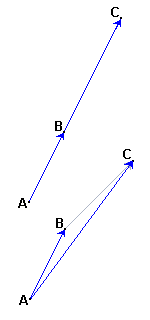|
ACTIVITY 4.6 |
|||
|
Vectors can be also useful to check if three or more points A, B, C, D, ..., are collinear, that is to say, if it exists a straight line that passes by all of them. We only will consider the case of three points A, B and C, all that we will say can become widespread in more than three points. If A,
B and C are collinear, then vectors If the coordinates of A, B and C are A(a1,a2), B(b1,b2) and C(c1,c2), then
and the parallelism condition between
|
 |
|
INTERACTIVE ACTIVITY Which of the next pair of three points A(a1,a2), B(b1,b2) and C(c1,c2) are collinear? Ascertain
it with the parallelism condition between a) A(-1,0), B(5,3) and C(2,-4) b) A(-5,-2), B(-1,0) and C(7,4) c) A(5,-3), B(1,3) and C(-2,6) d)
A(4,2), B(7,3) and C(-5,-1) |
|
| HOMEWORK |
|
b) Ascertain if the four points A(-4,-2), B(-1,-1), C(5,1) and D(11,3) are collinear. c) And five points A(9,-4), B(6,-2), C(0,2),
D(-3,4) and E(-5,6)? |
|
END OF ACTIVITY 4.6 |
|||